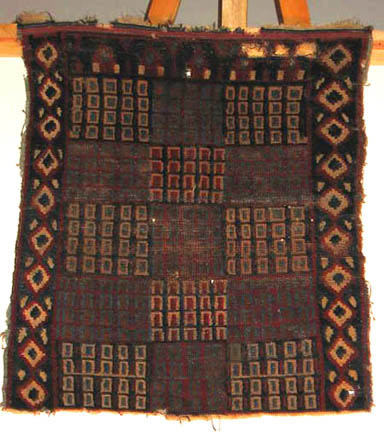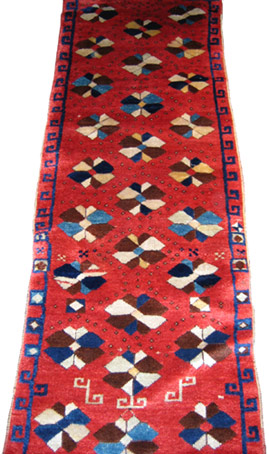Posted by Wendel Swan on 04-26-2006 04:13 PM:
Bakhtiyari? or Turkish beachball?
Dear all,
This pile fragment was in the Dealers’ Fair and caught the attention of many
eyes. During the course of the conference, the tag bore several attributions,
the last of which was Bakhtiyari. It had some white and blue cotton in the foundation,
lustrous wool and great colors.

A Chahar Mahal attrubtion was thought to be the most likely.
Jurg Rageth referred to the last rug as a “beachball” rug because of the appearance
of the unusual major elements. It has substantial and lustrous pile, with small
amounts of fuchsine that has by now faded to near white.

The panelists concurred that it is from Turkey, but no one could say whether
it is Central or Eastern.
Like the others in the Mystery Rugs session, no one had seen anything quite
like it.
Wendel
Posted by Steve Price on 04-27-2006 03:22 PM:
Hi Wendel
I don't recall the details right now, but I'm pretty sure one of Kirchheim's
rugs shown at the exhibition of his collection at the Hamburg ICOC was a Caucasian
with a "beachball" field.
I wonder whether the beachball rug in your post has had some borders trimmed
off it. I don't think I've seen anything quite like this, border-wise.
Regards
Steve Price
Posted by Wendel Swan on 04-27-2006 06:29 PM:
Steve, you may be thinking of Plate 29 in Kirchheim’s Orient Stars, a Caucasian
rug with the beachball look. I’m fairly certain that Bausback published it earlier.

That clearly is Caucasian and the “mystery rug” is just as clearly Anatolian
in the panel’s opinion. The only question was Central or East.
As to the sides, I think they were original. The pile was overall in nearly
pristine condition. Here is a detail of the rug on a Caucasian rug. The selvedges
on the other side were sometimes red.

More later on the connection between this beachball design and Swedish cushion
covers.
Wendel
Posted by louis_dubreuil on 04-28-2006 04:39 AM:
luri ?
Bonjour
At first glance, without any info about structure, the so called beachball rug
could be a free interpretation of the mina khani design by some inspired Luri
weaver. The freedom of the drawing, the light border, the shape of the hooks
, the colors make me to think of a Luri origin.
Note that the devices are quite different from the K. caucasian rug that do
not show any notch.
Louis
Posted by Wendel Swan on 04-28-2006 02:40 PM:
Dear all,
The universality of some designs is best illustrated by seeing this Swedish
cushion cover from 1815 in another variation of the "beachball" design.

This one seems to be in some sort of kilim or rolakan technique, not the twist
technique of the two other cushion covers that I posted.
While it is referred to as having "rosettes" I believe that this quadripartite
(here is appears to be octapartite) pattern has existed for at least 1,500 years
in various media clearly without a relationship to anything floral. If someone
stylized a rose or other flower, it was so long ago that the collective memories
of society could not remember it.
Scandinavian textiles copied many motifs from the Islamic lands.
Wendel
Posted by Wendel Swan on 05-01-2006 01:37 PM:
Here is an Afshar khorjin face. Lots of beachballs have been jammed into the
bag.

Wendel
Posted by Ed Krayer on 05-02-2006 07:04 AM:
Beachball Rug
Dear Steve, Wendel, et al.,
I first saw this mystery "beach ball" red field rug last year in Istanbul where
it had recently been sourced from Central Anatolia. I considered acquiring it,
and it appeared complete. It was quite lovely, and one could say, almost playful
and naive.
The unusual design and format stimulated a lot of conversation, of course, and
led us to still another plate shown by Ulrich Schurmann in "Caucasian Rugs,"
that had similar floral motifs scattered in the field. I am sorry I cannot offer
the exact reference at the moment, as I am traveling
The Turkish dealer who showed me this rug just days after it had entered the
market, and who subsequently placed this piece in the hands of a European seller,
claimed, with utter certainty, that it was from Karapinar.
Kind Regards,
Ed Krayer
Posted by Filiberto Boncompagni on 05-02-2006 10:21 AM:
John sent me two images with some comment. He’s busy so he asked me to post
some of the comment as well.
Filiberto -
You may have Schurmann but here are what I think are two images in his book
that may be similar to the "beach ball" design folks are discussing in the ACOR
8 minisalon.
The first is Plate 9 in Schurmann. He says it's a Bordjalou Kazak and 18th century.
He refers in his caption to a "flat" on "plate pages 33" where he says there
is further comment. There seems nothing relevant on page or plate 33 and all
of his flatweaves are at the back. I think he may have reference to Plate 140
on page 355 which he describes as a "Chila (flat stitch silk) That caption says
the this piece "possesses to a certain degree the character of early tile-like
decoration of Selkshuk rugs."
Please make a post after Mr. Krayer's in this thread using these images and
drawing on either what I've said above or you sense of what Schurmann is saying.
Thanks,
John Howe
Well, sadly I don’t have Schurmann’s book - considering its price I guess I’ll
have to wait for the next reprint – so I refrain from comments.
And here are the two scans:


Thanks and regards,
Filiberto







